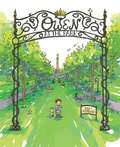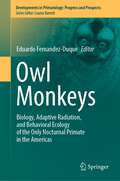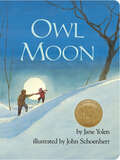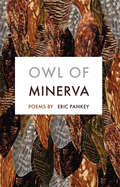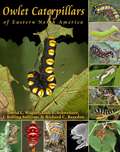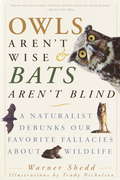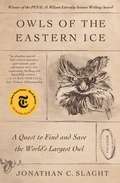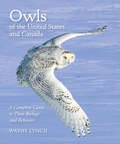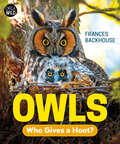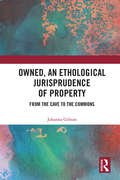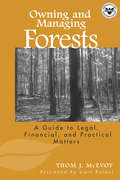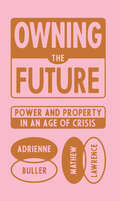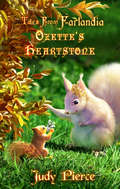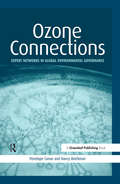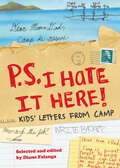- Table View
- List View
Owen at the Park
by Scot RitchieWorking with his dad in the park, Owen gets to do his favorite job all by himself. First, he clears the park of picnickers, checkers players, sleepy dogs and geese, and then the magic happens … It’s a busy morning in the park. All along the boulevard, families are picnicking and people are napping, playing checkers and reading on the grass. But Owen and his dad are hard at work, raking and mowing the grass. And today, Owen gets to do the best job all on his own. With his dad’s encouragement, Owen gathers his courage and goes around to everyone in the park. He tells the families, the checkers players and the readers what he has to do, and they rush off. Finally, when the park is empty, it is the moment Owen has been waiting for. He turns the tap for the sprinkler system, and water cascades over the trees and flower beds. In creating this book, Scot Ritchie was inspired by his trip to the beautiful Tiergarten park in Berlin. Owen at the Park is a sweet story illuminating the small pleasures in everyday life and the excitement of a child taking on new responsibilities. Key Text Features author’s note Correlates to the Common Core State Standards in English Language Arts: CCSS.ELA-LITERACY.RL.1.3 Describe characters, settings, and major events in a story, using key details. CCSS.ELA-LITERACY.RL.2.3 Describe how characters in a story respond to major events and challenges.
Owl & Friends
by Joyce WanI play with the squirrels, sing with the birds, and have a picnic with the deer. What am I? Children are asked to figure out just who does all these things in this delightful, bright board book. The last spread reveals it's a big, strong tree.
Owl Monkeys: Biology, Adaptive Radiation, and Behavioral Ecology of the Only Nocturnal Primate in the Americas (Developments in Primatology: Progress and Prospects)
by Eduardo Fernandez-DuqueThis book integrates three decades of owl monkey research conducted since 1994 when the first and only book focused on the genus Aotus was published. Owl monkeys were one of the least understood primates then; knowledge from wild populations was only beginning to emerge and there had been some substantial research in colonies of captive individuals. The situation is very different today. Research on captive owl monkeys has continued to develop, with valuable contributions to the health and medical sciences. And there is now enough information on the behavior, ecology, conservation, and biogeography of the genus that merits a synthesis. The book synthesizes new field data on the biogeography, behavioral ecology, circadian biology, population biology and demography spanning their entire continental range from Panamá to Argentina. It includes theoretical perspectives drawn from evolutionary biology, biological anthropology, anatomy, morphology and physiology, genetics, endocrinology and conservation biology to examine a specic set of adaptations that have allowed owl monkeys to exploit the nocturnal niche while functioning in a pair-living sexually monogamous system with remarkable patterns of paternal care. The author, with 30 years of research experience with both captive and wild primates, has directed the longest project on any owl monkey species and has conducted extensive original research on their biology, adaptive radiation and behavioral ecology. His expertise and published record on both wild populations and laboratory colonies makes this book one of a kind; it presents information from both captive and wild primates and explores questions through the integration of both approaches. The volume offers some additional features that make it novel in its approach: (1) brings together a combination of senior researchers who during four decades have established captive owl monkeys as a system of study with a new generation of younger scientists who have, for the last 10-20 years, been spearheading their study in the wild, (2) presents the work of a remarkably diverse range of authors representing all countries where owl monkeys are present, as well as researchers from the U.S and Europe, and (3) offers “synthesis” chapters; in doing so, it will surely become a reference book for those specifically drawn to owl monkeys, as well as for those interested in the research topics that are covered.
Owl Moon
by Jane YolenCelebrating 30 years of the beloved classic Owl Moon from renowned children's book author Jane Yolen and Caldecott Medal-winning illustrator John Schoenherr!Late one winter night a little girl and her father go owling. The trees stand still as statues and the world is silent as a dream. Whoo-whoo-whoo, the father calls to the mysterious nighttime bird. But there is no answer. Wordlessly the two companions walk along, for when you go owling, you don't need words. You don't need anything but hope. Sometimes there isn't an owl, but sometimes there is. Distinguished author Jane Yolen has created a gentle, poetic story that lovingly depicts the special companionship of a young child and her father as well as humankind's close relationship to the natural world. Wonderfully complemented by John Schoenherr's soft, exquisite watercolor illustrations, this is a verbal and visual treasure, perfect for reading aloud and sharing at bedtime.
Owl Moves Out of the Forest (Habitat Hunter)
by Nikki PottsOwl is bored with its habitat! Follow Owl as it tries out different places to live. Which habitat will make the best home for Owl?
Owl Sees Owl
by Laura Godwin Rob DunlaveyA School Library Journal Best Book of the Year"Simple yet stirring, this is perfect for preschooler bedtimes."— Booklist starred reviewFans of the classic picture book Owl Babies by Martin Waddell and Patrick Benson will adore this utterly simple picture book in which a baby owl goes off on his first adventure. With just three or four words per page, this story follows a baby owl one night as he leaves the safety of his nest (Home/Mama/Brother/Sister) and explores the starry world around him (Soar/Glide/Swoop/Swoosh). Inspired by reverso poetry, the words reverse in the middle when the baby owl is startled upon seeing his reflection in the pond (Owl/Sees/Owl). Afraid of it, little owl takes off toward home, soaring over farms and forests (Swoosh/Swoop/Glide/Soar) until he is finally safely home again (Sister/Brother/Mama/Home)."Fans of Jane Yolen&’s Owl Moon and Martin Waddell&’s Owl Babies will also love this calming story about an owl&’s first adventure." —School Library Journal, Starred
Owl of Minerva: Poems
by Eric PankeyA Walt Whitman Award–winning poet seeks the spiritual within everyday physical objects in this luminous collection.Taking its name from the Roman goddess of wisdom and her companion bird, Owl of Minerva turns astonishingly precise attention to the physical world, scouring it for evidence of the spiritual as the poet travels through such places as Appalachia, New England, Venice, Spain, the Caribbean, and the American Midwest. Along the way, Eric Pankey ponders mortality, religious narratives and iconography, the continued press of childhood on the present, and the simultaneous violence and beauty of the natural world.At the book’s core are three ambitious poems titled “The Complete List of Everything,” which together offer an extended vision of American longing and connection—as well as a window into the sort of compendium of images and moments a sustained devotion to poetry can yield. “The hope was to construct // A coherent totality of meaning from odds / And ends,” Pankey writes, and so much of this book is about the difficult work of constructing meaning from the available material all around us. This book is an extraordinary example of lyric-meditative journaling—a large and profound collection by a brilliant poet writing at the height of his powers.“Pankey remains one of our leading practitioners of the metaphysical poem.” —C. Dale Young, author of Prometeo
Owlet Caterpillars of Eastern North America
by David L. Wagner J. Bolling Sullivan Richard C. Reardon Dale F. SchweitzerThis lavishly illustrated field guide features more than 800 species of the most common, interesting, beautiful, and important owlet (noctuid) caterpillars found in eastern North America. More than 2,100 color photographs include numerous stunning images, and the guide's introductory sections offer a wealth of information on noctuid natural history, morphology, larval diets, natural enemies, and classification; suggestions for finding and rearing owlet caterpillars; and much more. The 375 full-page species accounts treat similar species, range, phenology, and larval foodplants. A remarks section addresses behavior, life history, taxonomy, and a variety of other general interest topics. For full species accounts, two adult images are provided, one of a spread museum specimen and the other of a live adult: this is the first guide to comprehensively provide images of live adult moths in representative resting postures. An extensive glossary and foodplant index are also included.More than 800 species of eastern owlets More than 2,100 color photographs illustrating many species for the first time First North American insect guide to offer hundreds of images of live moths in their natural resting postures Extensive information on owlet biology, natural enemies, classification, and finding and rearing owlet caterpillars Includes foodplant records for each species and foodplant index
Owls
by Matt SewellAn enchanting illustrated guide to owl species of the world.In this beautiful and highly giftable art book, artist and ornithologist Matt Sewell captures 50 species of the world's most evocative bird: the owl. Using pop-art watercolors and accompanied by witty and irreverent descriptions, Sewell expresses the individual characters of owls as never before. From tiny elf owls to huge Eurasian eagle owls, from the haunting barn owl to the elegant great horned owl, these wise, magical birds are otherworldly in their striking colors and stature. It's not just birdwatchers who are obsessed: Owls are a perennial favorite in pop culture, decorating, and among children as well as nature lovers and serious birders. From David Sedaris's Let's Explore Diabetes with Owls to Harry Potter's pet Hedwig, and throwback interest in Twin Peaks (which is returning to TV in 2016) and its trademark spooky owls, these birds are here to stay.
Owls (Nature's Children)
by Elin KelseyHow many different kinds of owls are there? What do owls eat? What is a baby owl called? Find the answers to these questions, and learn much more about the physical characteristics, behavior, habitat, and lives of owls. Other books in this series are available in this library.
Owls Aren't Wise and Bats Aren't Blind: A Naturalist Debunks Our Favorite Fallacies About Wildlife
by Warner SheddDid you know that "flying" squirrels are incapable of true flight? Were you aware that opossums don't "play dead," as in the common folk saying "playing possum"? In this fascinating and gorgeously illustrated new book, wildlife expert and enthusiast Warner Shedd, former executive for the National Wildlife Federation, uncovers the scientific realities obscured by our numerous long-held misconceptions of wild animals. Setting the most tenacious of these age-old superstitions against evidence that he and other biologists and naturalists have gleaned from careful observation and investigation, Shedd refutes such popular myths as beavers can fell trees in a desired direction, gray squirrels remember where they bury nuts, wolves howl at the moon, and cougars are an endangered species. In addition to dispelling misinformation,Owls Aren't Wise & Bats Aren't Blindpresents some fascinating facts about the animals that many of us encounter in our own backyards or walking across the road as we drive in our cars. For instance, did you know that a porcupine is actually a large rodent, and that its protective quills are really specialized hairs numbering about 30,000 per animal? That means that a typical porcupine has about 140 quills per square inch! Shedd also uses humorous anecdotes to show us how funny (and educational) it can be when animals themselves defy our mistaken beliefs about them. Casting new light on the old tenet that ravens can be taught to mimic the human voice, Warner Shedd tells of a scientist who spent six years teaching a raven to cry "nevermore," after the haunting raven in the famous Edgar Allan Poe poem. Shedd further explains that recent research indicates that ravens only mimic if they have the desire to do so. Owls Aren't Wise & Bats Aren't Blindcovers more than thirty North American species--some as familiar as the common toad, others as elusive as the lynx. And Shedd captivates the reader as only an experienced naturalist could, with detailed, accurate information on such varied wildlife as muskrats, herons, brown bears, crows, armadillos, and coyotes--to name only a few. Owls Aren't Wise & Bats Aren't Blindgrew out of Warner Shedd's desire to share biologically sound information and counter erroneous folklore about wild animals. By arming his readers with knowledge, Shedd hopes to promote a more informed and respectful view of many North American wildlife species and ultimately encourage the scientific management and conservation of all our native wildlife.
Owls and Other Birds of Prey (World Book's Animals of the World)
by Mary E. ReidHow do Owls see in the dark? How can they fly silently? Do bald eagles steal from other birds? What is the fastest bird in the world? Find out the answers to these and other questions in this fascinating book on birds of prey.
Owls and Other Fantasies: Poems and Essays
by Mary OliverA perfect introduction to Mary Oliver&’s poetry, this stunning collection features 26 nature poems and prose writings about the birds that played such an important role in the Pulitzer Prize winner&’s life. Within these pages you will find hawks, hummingbirds, and herons; kingfishers, catbirds, and crows; swans, swallows and, of course, the snowy owl, among a dozen others-including ten poems that have never before been collected. She adds two beautifully crafted essays, &“Owls,&” selected for the Best American Essays series, and &“Bird,&” a new essay that will surely take its place among the classics of the genre.In the words of the poet Stanley Kunitz, &“Mary Oliver's poetry is fine and deep; it reads like a blessing. Her special gift is to connect us with our sources in the natural world, its beauties and terrors and mysteries and consolations.&”For anyone who values poetry and essays, for anyone who cares about birds, Owls and Other Fantasies will be a treasured gift; for those who love both, it will be essential reading.This book was published with two different covers. Customers will be shipped the book with one of the available covers.
Owls of the Eastern Ice: A Quest to Find and Save the World's Largest Owl
by Jonathan C. SlaghtA New York Times Notable Book of 2020Longlisted for the National Book AwardWinner of the PEN/E.O. Wilson Literary Science Writing Award and the Minnesota Book Award for General NonfictionA Finalist for the Stanford Dolman Travel Book of the Year AwardWinner of the Peace Corps Worldwide Special Book AwardA Best Book of the Year: NPR, The Wall Street Journal, Smithsonian, Minneapolis Star-Tribune, The Globe and Mail, The BirdBooker Report, Geographical, Open Letter ReviewBest Nature Book of the Year: The Times (London)"A terrifically exciting account of [Slaght's] time in the Russian Far East studying Blakiston’s fish owls, huge, shaggy-feathered, yellow-eyed, and elusive birds that hunt fish by wading in icy water . . . Even on the hottest summer days this book will transport you.” —Helen Macdonald, author of H is for Hawk, in KirkusI saw my first Blakiston’s fish owl in the Russian province of Primorye, a coastal talon of land hooking south into the belly of Northeast Asia . . . No scientist had seen a Blakiston’s fish owl so far south in a hundred years . . . When he was just a fledgling birdwatcher, Jonathan C. Slaght had a chance encounter with one of the most mysterious birds on Earth. Bigger than any owl he knew, it looked like a small bear with decorative feathers. He snapped a quick photo and shared it with experts. Soon he was on a five-year journey, searching for this enormous, enigmatic creature in the lush, remote forests of eastern Russia. That first sighting set his calling as a scientist.Despite a wingspan of six feet and a height of over two feet, the Blakiston’s fish owl is highly elusive. They are easiest to find in winter, when their tracks mark the snowy banks of the rivers where they feed. They are also endangered. And so, as Slaght and his devoted team set out to locate the owls, they aim to craft a conservation plan that helps ensure the species’ survival. This quest sends them on all-night monitoring missions in freezing tents, mad dashes across thawing rivers, and free-climbs up rotting trees to check nests for precious eggs. They use cutting-edge tracking technology and improvise ingenious traps. And all along, they must keep watch against a run-in with a bear or an Amur tiger. At the heart of Slaght’s story are the fish owls themselves: cunning hunters, devoted parents, singers of eerie duets, and survivors in a harsh and shrinking habitat.Through this rare glimpse into the everyday life of a field scientist and conservationist, Owls of the Eastern Ice testifies to the determination and creativity essential to scientific advancement and serves as a powerful reminder of the beauty, strength, and vulnerability of the natural world.
Owls of the United States and Canada: A Complete Guide to Their Biology and Behavior
by Wayne LynchNamed One of the Best Reference Books of 2007 by Library JournalThere is no group of birds more mysterious and fascinating than owls. The loudmouths of the raptor world, they peep, trill, toot, bark, growl, shriek, whistle, chittle, whoop, chuckle, boom, and buzz. Indeed, very few actually "hoot." They have become the stuff of lore and legend—from the Roman myth that an owl foot could reveal secrets to the First Nations belief that an owl feather could give a newborn better night vision. But the truth about owls is much more exciting.In this gorgeous book, celebrated natural history writer and wildlife photographer Wayne Lynch reveals the secrets of these elusive species with stunning photographs, personal anecdotes, and accessible science. The photos alone are masterpieces. Unlike most published owl photos, which are portraits of birds in captivity, the vast majority of these were taken in the wild—a product of the author-photographer's incredible knowledge and patience. Lynch complements the photos with a wealth of facts about anatomy, habitat, diet, and family life. For each of the nineteen species that inhabit Canada and the United States, he provides a range map and a brief discussion of its distribution, population size, and status. Lynch debunks myths about owls' "supernatural" powers of sight and hearing, discusses courtship rituals, and offers personal tips for finding owls in the wild. From the great horned to the tiny elf owl, this amazing volume captures the beauty and mystery of these charismatic birds of prey.
Owls on the Prowl, Phonics Reading Program # 28
by Anne Schreiber"Some owls live in the snow. The Snowy Owl is white and brown It blends in with snow and rocks. Even when it roosts out in the snow, it can't be found. The Snowy Owl has soft down close to its skin. This keeps in body heat." Other books in this series are available from Bookshare.
Owls: A Guide to Every Species in the World
by Marianne TaylorDiscover the fascinating and mysterious world of owls with this stunning full-color, encyclopedic visual guide that explores all 225 known species, packed with maps, photographs, illustrations, informative scientific details, and a bonus 35½" x 12" accordion poster illustrated with the true-to-size wing span of the largest owl, overlayed with the wing span of the smallest owl and several owls in-between.Humans have long been fascinated by owls. From prehistoric cave paintings to popular modern children’s stories, these magnificent predators have been seen as harbingers of good fortune and impending disaster, as icons of fear and wisdom, and as the powerful sidekicks of magic-makers, including the beloved Harry Potter. Scientists have faced tremendous challenges trying to document the lives of these solitary, nocturnal, and highly elusive creatures. New species are still being discovered, as are new insights into the habits of even the most familiar varieties. Visually spectacular and authoritative, Owls includes full descriptions and maps of key viewing locations for all 225 owl species in the world, and is illustrated with drawings and stunning full-color images from some of the leading wildlife photographers from around the world which capture these birds’ breathtaking beauty and power. The book also features a special section on the art of hiding—a highly honed skill set of the owl.Throughout, Marianne Taylor provides a wealth of detail on each type of bird’s hunting and breeding behavior, habitat, and conservation. Inside, are dozens of fun facts, such as: Only nineteen of the 225 known species of owls are found in North America;Owls can be found on all continents except Antarctica;Owls, like humans, have binocular vision;Owls cannot turn their eyes, but are able to rotate their heads up to 270 degrees;Owls are carnivorous and are known to eat rodents, small mammals, nocturnal insects, fish, and other birds. Lavishly illustrated and educational, this breathtaking volume is essential for readers interested in natural science, devout birders, professional ornithologists, and all owl lovers.
Owls: Who Gives a Hoot? (Orca Wild #13)
by Frances BackhouseKey Selling Points Owls are among the world’s most easily recognized and culturally significant birds. Although owls are extremely popular, most people rarely see them and don’t know a lot about them. This book features photos of all 19 species that live in Canada and the United States and is filled with information about these mysterious birds. It is timely because there is a strong push happening in many parts of North America to restrict the use of rodent poisons that are taking a heavy toll on owls and other predators that eat the poisoned rodents. Encourages kids to get actively involved in learning more about owls and ensuring their survival and includes profiles that present real-life examples of kids who are helping owls in various ways. Frances Backhouse is an award-winning science writer of nonfiction books for adults and kids. She has already written two books in the Orca Wild series (Beavers and Grizzly Bears ). She also has an adult nonfiction book on owls, Owls of North America .
Owned, An Ethological Jurisprudence of Property: From the Cave to the Commons
by Johanna GibsonThis book draws upon domestication science to undertake a radical reappraisal of the jurisprudence of property and intellectual property. Bringing together animal studies and legal philosophy, it articulates a critique of dominant property models and relationships from the perspective of cognitive ethology, domestication science and animal behaviour. In doing so, a radical new picture of property emerges. Focusing on the emergence of property models through prevailing ideas of human domestication and settlement, the book challenges the anthropocentrism that informs standard approaches to ownership and to authorship. Utilising a wide range of examples from ethology and animal studies, the book thus rethinks the very nature of property as uniquely human. This highly original contribution to the fields of property and intellectual property will appeal not only to legal scholars in these areas, as well as in animal law, but also to legal theorists and others working in the social sciences with interests in posthumanism and animal studies.
Owning and Managing Forests: A Guide to Legal, Financial, and Practical Matters
by Carl Reidel Thomas J. McevoyOwning and Managing Forests is both an accessible overview of the privileges, rights, and obligations that accompany forest ownership and a guidebook to help active forest owners and managers use laws to their advantage and avoid the pitfalls of expensive and exhausting litigation. The book is a revised, expanded, and updated edition of Legal Aspects of Owning and Managing Woodlands, published in 1998 by Island Press and named Best Forestry Book of the Year by the National Woodland Owners Association.This edition provides current information on recent changes in property, environmental, and tax laws, while also discussing new directions in forest management. It offers expanded treatment of topics including private property, searching property records, easements, estate planning, timber sale contracts, working with forestry professionals, and how to pass woodlands intact to future generations. The book also describes the many different facets of trusts, changes in forestland taxation methods, and new licensing and certification options. Included, too, is a section on avoiding disputes and how to use alternative dispute resolution methods to avoid costly, troubling, and time-consuming court battles.Owning and Managing Forests provides clear and concise descriptions of often confusing concepts and difficult subjects, and addresses issues in a competent yet conversational tone. Anyone involved with owning or managing forestland will find the book an essential guide and reference.
Owning the Future: Power and Property in an Age of Crisis
by Mathew Lawrence Adrienne BullerA radical manifesto for the transformation of post-pandemic politicsThe question of ownership is the critical fault line of our times. During the pandemic this issue has only become more divisive. Since March 2020 we have witnessed the extraordinary growth of asset manager capitalism and the explosive concentration of wealth within the hands of the already super-rich. This new oligarchy controls every part of our social and economics lives.In the face of crisis, the authors warn that mere redistribution within current forms of ownership is not enough; our goal must be to go beyond the limits of the current system, dominated by private enclosure and unequal ownership. Only by reimagining how our economy is owned and by whom can we address the crises of our time - from the fallout of the pandemic to ecological collapse - at their roots.Building from this insight, the authors argue the systemic change we need hinges on a new era of democratic ownership: a reinvention of the firm as a vehicle for collective endeavour and meeting social needs. Against the new oligarchy of the platform giants, a digital commons that uses our data for collective good, not private profit. In place of environmental devastation, a new agenda of decommodification - of both nature and needs - with a Green New Deal and collective stewardship of the planet&’s natural wealth. Together, these proposals offer a road map to owning the future, and building a better world.
Ozette's Destiny: Tales From Farlandia (Tales From Farlandia #1)
by David M. F. Powers Judy Pierce Natalia Nesterova Silvia HoefnagelsAfter being crowned the queen of Farlandia, the white squirrel Ozette finds herself in the midst of a struggle to save the endangered and enchanted forest where she now lives. Can Ozette round up the help she needs to preserve the rhythms of nature that make Farlandia so special? In order to accomplish this gigantic feat, the white squirrel must enter the world of deep, forest magic in an attempt to save her chosen family. But is she ready to learn the truth about the land she loves? She enlists the help of ethereal fairies, elusive elves, and her newest friend Gizmo as they find themselves in a desperate race against Boardmore, Smiley, and time. Under the guidance of Princess Abrianna and the direction of Queen Beatrix, Ozette learns more about her new home than she could have imagined. The secrets that nature holds can only be unlocked when you embark on yet another magical journey with Ozette and her enchanting friends. Are you ready to learn the truth about Farlandia?
Ozette's Heartstone
by David M. F. Powers Judy Pierce Natalia Nesterova Silvia Hoefnagels Leah WatkinsAfter being crowned the queen of Farlandia, the white squirrel Ozette finds herself in the midst of a struggle to save the endangered and enchanted forest where she now lives. Can Ozette round up the help she needs to preserve the rhythms of nature that make Farlandia so special? In order to accomplish this gigantic feat, the white squirrel must enter the world of deep, forest magic in an attempt to save her chosen family. But is she ready to learn the truth about the land she loves? She enlists the help of ethereal fairies, elusive elves, and her newest friend Gizmo as they find themselves in a desperate race against Boardmore, Smiley, and time. Under the guidance of Princess Abrianna and the direction of Queen Beatrix, Ozette learns more about her new home than she could have imagined. The secrets that nature holds can only be unlocked when you embark on yet another magical journey with Ozette and her enchanting friends. Are you ready to learn the truth about Farlandia?
Ozone Connections: Expert Networks in Global Environmental Governance
by Penelope Canan Nancy ReichmanIt is difficult to think of a more significant example of international cooperation to address a problem that threatened the health and wellbeing of the entire planet than the 1987 Montreal Protocol for the Elimination of Ozone-Depleting Substances. This breakthrough in international environmental governance has proved to be an extraordinary success beyond rhetoric or promises. In a dozen years, this international agreement went from an understanding of the need to act in a precautionary manner for mutual benefit to a successful worldwide effort to eliminate chemical substances harmful to our protective ozone layer. The production and consumption of most ozone-depleting substances has now been phased out in developed countries, with developing countries not far behind. What happened and why is of tremendous importance for those looking for guidance in the future, particularly those now involved in hugely complicated negotiations on climate change. The success of the Montreal Protocol has been linked to many factors such as political will, treaty flexibility and the recognition of equity issues raised by developing countries. While comprehensively analysing all of these success factors, Ozone Connections goes on to suggest that a social organization of global governance as typified by the protocol's Technical and Economic Assessment Panel (TEAP) was a unique – but replicable – decisive factor. The book argues that we need to understand how the implementation of complex global environmental agreements depends on the construction and exploitation of social connections among experts who act collectively to define solutions to environmental problems. This highly original and provoking thesis synthesises some of the more exciting social science concepts and methods, while refining our basic understanding of environmental social change and providing policy-makers with concrete success factors to replicate. This book will be essential reading for academics in the fields of sociology, political science, international relations, network studies, human communication, motivation, collaboration and leadership, as well as the burgeoning interdisciplinary field of environmental studies. Businesses will also find many applications for practical use. Finally, the many directly transferable lessons from ozone layer protection make this book a key addition to the growing literature on climate change.
P.S. I Hate It Here: Kids' Letters from Camp
by Diane FalangaHeartwarming and hilarious real-life letters from kids at summer camp sure to amuse anyone who’s ever been a homesick child or a parent of one.In the bestselling tradition of nostalgic looks at classic rites of passage, such as Camp Camp and Bar Mitzvah Disco, P.S. I Hate It Here: Kids’ Letters from Camp captures a childhood experience shared by millions. This collection of real letters written by children ages eight to sixteen to their parents about their adventures at summer camp are laugh-out-loud funny and will have readers reminiscing about their own camp days.More than 150 letters cover all the imaginable scenarios of sleep away camp, from acing the cabin lice inspection, to rowing in the “ricotta” race, to breaking the bad news about a retainer lost in the wilderness. These letters reveal that kids are wittier and more sophisticated than we might assume, and that the experience of being away from home for the first time creates hilarious and lasting memories.“Trust me when I tell you that not only will your kids get a kick out of the amazingly funny letters contained in this book, you and your friends will too.” —Chicago Parent Magazine“P.S. I Hate It Here”compiles notes home from camp with love—a handsome, actually quite beautiful, little book.” —Chicago Tribune“Whether your kid is in camp or you cherish your own memories of s'mores and Color Wars, you'll get a kick out of P.S. I Hate It Here!, a book of real-life, laugh-out-loud letters from camp.” —Redbook Magazine
